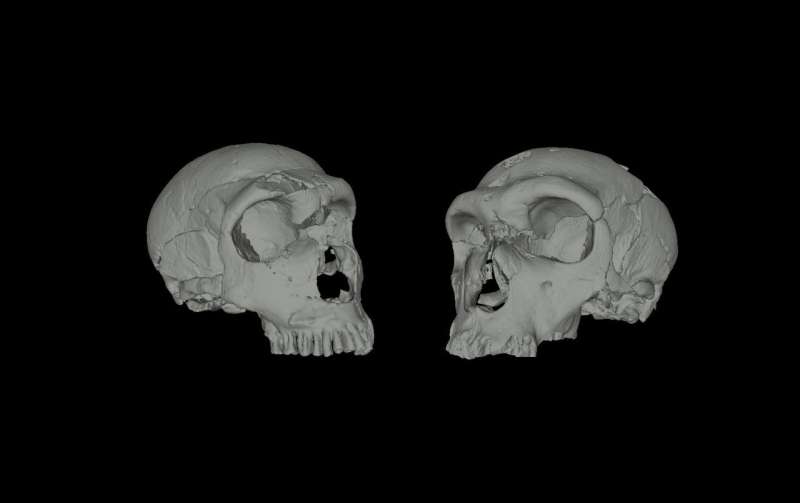October 31, 2017 report
Cold temperatures found to cause nasal structure similarities between Neanderthal and modern humans

(Phys.org)—An international team of researchers has found that Neanderthals and modern humans both evolved in ways that allowed for better breathing through the nose in a cold climate. In their paper published in Proceedings of the National Academy of Sciences, the group also notes that there were similarities in the ways that both adapted to the cold.
In order to breathe through the nose when it is really cold outside, the air that is inhaled must be both warmed and humidified to prevent damaging sensitive lung tissue. We humans have evolved to allow this. And as it turns out, Neanderthals did, too. But, it took some roundabout research to make this discovery because much of the internal nasal configuration is made of soft tissue, which does not appear in the fossil record. To overcome that problem and to learn more about the ways both groups evolved to deal with the cold Eurasian climate, the researchers studied the nasal cavities of 38 modern Argentinians, 26 Southwestern Europeans, 12 Northeastern Asians and two Neanderthal. The team then used data from the modern humans and software to digitally reconstruct the soft nasal tissue inside the Neanderthal nasal cavity and compared it to the modern human nose.
The researchers report that though the two groups had different nose shapes (Neanderthal noses were shorter and broader than modern human noses) there were internal similarities between them that their research showed evolved independently. They also compared air warming and humidifying efficiencies between the groups. They report that they found Northeastern Asians were the best at breathing in cold air and that the Neanderthal came in second. Those of Southwestern European descent were the worst.

Both groups also evolved other adaptions to deal with the cold, such as growing more hair and becoming wider in the thoracic area. Some have suggested that the Neanderthal may have adapted too well to the cold and that might have been part of the reason the group went extinct—they could not handle the warmer temperatures that came later. This new research suggests if that was the case, it was not likely due to an inability to breathe warmer air.
More information: S. de Azevedo et al. Nasal airflow simulations suggest convergent adaptation in Neanderthals and modern humans, Proceedings of the National Academy of Sciences (2017). DOI: 10.1073/pnas.1703790114
Abstract
Both modern humans (MHs) and Neanderthals successfully settled across western Eurasian cold-climate landscapes. Among the many adaptations considered as essential to survival in such landscapes, changes in the nasal morphology and/or function aimed to humidify and warm the air before it reaches the lungs are of key importance. Unfortunately, the lack of soft-tissue evidence in the fossil record turns difficult any comparative study of respiratory performance. Here, we reconstruct the internal nasal cavity of a Neanderthal plus two representatives of climatically divergent MH populations (southwestern Europeans and northeastern Asians). The reconstruction includes mucosa distribution enabling a realistic simulation of the breathing cycle in different climatic conditions via computational fluid dynamics. Striking across-specimens differences in fluid residence times affecting humidification and warming performance at the anterior tract were found under cold/dry climate simulations. Specifically, the Asian model achieves a rapid air conditioning, followed by the Neanderthals, whereas the European model attains a proper conditioning only around the medium-posterior tract. In addition, quantitative-genetic evolutionary analyses of nasal morphology provided signals of stabilizing selection for MH populations, with the removal of Arctic populations turning covariation patterns compatible with evolution by genetic drift. Both results indicate that, departing from important craniofacial differences existing among Neanderthals and MHs, an advantageous species-specific respiratory performance in cold climates may have occurred in both species. Fluid dynamics and evolutionary biology independently provided evidence of nasal evolution, suggesting that adaptive explanations regarding complex functional phenotypes require interdisciplinary approaches aimed to quantify both performance and evolutionary signals on covariation patterns.
Journal information: Proceedings of the National Academy of Sciences
© 2017 Phys.org




















